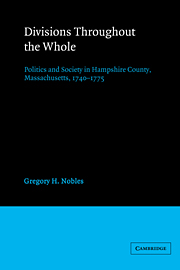Book contents
- Frontmatter
- Contents
- Preface
- Introduction
- 1 Family power and political relations in Hampshire County
- 2 The Hampshire County ministry and the Great Awakening: from revival to reaction
- 3 The revivalist removed
- 4 The legacy of religious dissent
- 5 New settlements in an unsettled society
- 6 The politics of parochialism
- 7 Revolution in the neighborhood
- Appendix
- Notes
- Bibliographical essay
- Index
6 - The politics of parochialism
Published online by Cambridge University Press: 30 September 2009
- Frontmatter
- Contents
- Preface
- Introduction
- 1 Family power and political relations in Hampshire County
- 2 The Hampshire County ministry and the Great Awakening: from revival to reaction
- 3 The revivalist removed
- 4 The legacy of religious dissent
- 5 New settlements in an unsettled society
- 6 The politics of parochialism
- 7 Revolution in the neighborhood
- Appendix
- Notes
- Bibliographical essay
- Index
Summary
In the many histories of New England towns, the story of growth and division has become a very familiar one. Throughout the seventeenth and eighteenth centuries the process occurred so often as to seem an almost natural part of development, perhaps even a predictable event in the overall demographic history of any town. The patterns of land use and family size common in colonial American society led unavoidably to the dispersal of a town's population, and somewhat like amoebas, many towns divided as they grew larger and more spread out. Without defining any rigid standards of maximum population size or distance, early New Englanders nevertheless followed the practice of town division repeatedly and arranged themselves across the landscape in a pattern of regularly spaced small towns.
And yet the orderly appearance is deceptive. However commonplace or predictable, the division of a town was still a political as well as a demographic phenomenon. It was determined not just by some function of population, time, and geography, but by human consciousness, choice, and action. In a sense there emerged two differing ideas of community, one defined by identification with the original town as a whole, the other based on identification with a particular section within that town. Shared lands and shared disadvantages helped create shared interests, and outlying residents began to recognize those interests and to act together as a group.
- Type
- Chapter
- Information
- Divisions throughout the WholePolitics and Society in Hampshire County, Massachusetts, 1740–1775, pp. 132 - 154Publisher: Cambridge University PressPrint publication year: 1983

